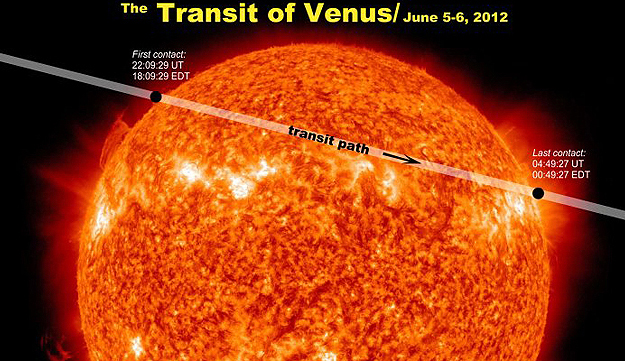Science Planned on JCMT During Transit of Venus

The James Clerk Maxwell Telescope (JCMT) on Mauna Kea in Hawaii is one of the few telescopes in the world capable of directly observing the planet Venus as it transits across the face of the Sun, and it plans to take full advantage of this last opportunity for 115 years.
The transit of Venus, occurring on 5th June 2012, is when Venus passes directly between the Sun and the Earth; as it does so, it can be seen as a tiny disk crossing the face of the Sun. This is one of the rarest astronomical events and will not be seen again until 2117.
Very few telescopes will be able to observe this event as they cannot point directly at the Sun without destroying their delicate instruments. The JCMT, the largest dedicated submillimeter telescope in the world, has no such problem and is the only telescope out of the ten on the summit of Mauna Kea with this capability. Its dish is protected by a screen of Gore-Tex fabric — the largest single piece in the world — which blocks the damaging solar radiation, while still allowing the submillimeter light to pass through.

Brad Sandor of the Space Science Institute in Boulder, Colorado, will be at the JCMT on 5th June to observe the transit. Sandor regularly uses the JCMT to observe Venus. The data he collects is analyzed to measure the temperature, wind speed and chemical composition of the Venusian atmosphere.
The JCMT data he will collect during transit will be combined with simultaneous observations by SOIR, an infrared instrument on board the Venus Express orbiter. SOIR collects the Sun’s radiation after it has passed through the upper layers of Venus’s atmosphere.
But why is it so important to observe Venus during transit? As Sandor explains, “normally the JCMT can only observe Venus during the day or night time, never in-between. SOIR on the other hand can only observe at twilight. During transit is the one time we can collect twilight data with the JCMT and allow us to directly compare two simultaneous, but different, observations”.
The transit of Venus has had special significance in Hawaii since 1874 when King Kalakaua invited astronomers from Britain and the US to view the transit from Honolulu. The offer was eagerly accepted as the scientists were keen to use the transit in order to calculate the distance from the Earth to the Sun. Once this was achieved they could then work out the size of the whole solar system.
Venus is considered the sister planet of Earth, being a similar size, mass and age. Yet underneath its thick clouds, the surface is a toxic cauldron of chemicals. Its atmosphere is over 95% carbon dioxide, a powerful greenhouse gas that results in daytime temperatures of around 900F. The surface of Venus is riddled with thousands of extinct volcanoes; it has an atmospheric pressure 92 times greater than Earth and rains sulphuric acid. Understanding how its climate got into this extreme state may prove relevant to understanding the evolution of our own atmosphere.
Media Contacts:
Antonio Chrysostomou
Joint Astronomy Centre
a.chrysostomou@jach.hawaii.edu
+1 808-969-6512
Holly Thomas
Joint Astronomy Centre
h.thomas@jach.hawaii.edu
+1 808-969-6531
Science Contact:
Brad Sandor
Space Science Institute, Boulder, CO
+1 720-974-5829
sandor@spacescience.org
Video of Brad Sandor discussing these observations http://www.youtube.com/watch?v=FEC3S3Mft9E
Learn more about Venus and the SOIR instrument at the Belgian Institute for Space Aeronomy: http://venus.aeronomie.be/en/transit/index.htm
Submillimeter Light
Submillimeter wavelengths are much smaller wavelengths than emitted by a typical radio station, but longer wavelengths than light waves or infrared wavelengths.
They are typically measured in microns, also called micrometers. One micron is one millionth of a meter, or one 10,000th of a centimeter, or one 25,000th of an inch.
Submillimeter astronomy is most sensitive to very cold gas and dust. For example, a source with a temperature of 10 K (-263 degrees C) emits most of its energy in a broad spectral region centered around 300 microns. Such very cold material is associated with objects in formation, that is, the mysterious earliest evolutionary stages of galaxies, stars and planets. If one wants to understand the origins of these most fundamental of astronomical structures, the submillimeter is the waveband of choice.
James Clerk Maxwell Telescope
The James Clerk Maxwell Telescope (JCMT) is the world’s largest single-dish submillimeter-wave telescope. It collects faint submillimeter-wavelength signals with its 15 meter diameter dish. It is situated near the summit of Mauna Kea on the Big Island of Hawaii, at an altitude of approximately 4000 meters (14000 feet) above sea level. It is operated by the Joint Astronomy Centre, on behalf of the UK Science and Technology Facilities Council, the Canadian National Research Council, and the Netherlands Organization for Scientific Research. http://www.jach.hawaii.edu/JCMT









